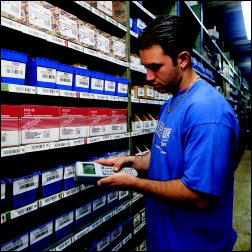
A plumbing wholesaler in the competitive pressure-cooker that's New York City doesn't reach its 75th anniversary by resting on its accomplishments.
Davis & Warshow has climbed to the forefront of New York wholesalers by taking an innovative approach to the market and by anticipating its customers' needs. The company surpassed $50 million in sales last year by staying a step ahead of the competition.
That's not to say, however, that Davis & Warshow doesn't honor its past. In April, the wholesaler took a break from its hectic schedule to host its industry friends at a black-tie dinner at the Ellis Island Memorial.
But, true to its heritage of hard work, the company did not devote the entire day to fond memories. That same morning and afternoon, Davis & Warshow held its biennial trade show at its Maspeth, N.Y., headquarters where it demonstrated its latest initiatives in its paperless warehouse, on the Internet and with a pricing CD-ROM for its contractor customers.
The technological innovations, new as they may be, really are part of the tradition of a company that always has positioned itself in the forefront of the industry. This, after all, is the same plumbing wholesaler that installed its first computer system in the mid-1950s. It's also a company that understands that technology is a tool to increase its employees' - and its customers' - productivity.
"We want to create an environment to give our customers the opportunity to do their work better," President Frank Finkel says. "We believe we can give them reasons to do business with us that don't depend solely on price."

They did it
Detailing 75 years of company history is beyond the scope of this story. What's fascinating to note, though, are the origins of some of Davis & Warshow's strongest characteristics today.For starters, there really were a Mr. Davis and a Mr. Warshow. Besides their strong work ethic and founding the company that bears their name, the two may be remembered best for two accomplishments.
First, Bernie Davis and Louis Warshow started the practice of getting their delivery wagon on the street in the predawn hours, thereby avoiding New York's rush-hour traffic jams even 75 years ago. It's an early-morning tradition that Davis & Warshow's 20 delivery trucks carry on to this day as they leave Maspeth, just across the East River from Manhattan in Queens, on their way to the wholesaler's six branches and customers' jobsites. Each truck is equipped with a state-of-the-art communication system.
Their second major accomplishment was hiring Davis' nephew Irving Finkel in 1934. Irving Finkel rose quickly through the company, becoming part owner just seven years later. He eventually became sole owner in 1966. Company chairman to this day, Irving Finkel celebrated his 87th birthday in June.
"My father is still a guiding force for us," Frank Finkel says. "He stays in New York through the fall and comes in the office most days."
During Irving Finkel's early years with the company, Davis & Warshow cultivated its niche among the city's smaller repair and service plumbers. Forced out of large construction projects by the city's bigger wholesalers, Davis & Warshow targeted the city's aging building stock. Its knowledge of that market and its relationships with service contractors served Davis & Warshow well in the mid-1970s and early 1990s, after the company had grown considerably larger. During both decades, economic downturns brought construction in the city to a standstill.
"When you look into New York buildings, you see the world's biggest supply of old plumbing," Frank Finkel says. "It's in constant need of repair and renovation. That kept us going until the city was revitalized."
After World War II, Davis & Warshow also distinguished itself by diversifying into new markets such as the PVF used in the city's high-rises, establishing its own pipe-fabrication shop. Later, the wholesaler launched its high-end plumbing showroom operation.
The company's motto of "We can do anything" has evolved into "We do it," and its taste for pioneering new markets remains. Prompted by changes in New York's building codes that require sprinklers in new buildings and major renovations, Davis & Warshow has made a name for itself in the fire-protection market. Its pipe shop now is fully equipped to fabricate sprinkler systems. The company also has deepened its concentration in the PVF market with a new computerized plasma hole-cutter and welder.
Nowhere, however, has the company demonstrated its pioneering spirit more than in technology. Besides its move to computers in the 1950s, other milestones include its first billing machine in 1945; an early version of the fax machine in the late 1960s; EDI in the mid-1980s; and branch computer hookups and voice mail in the late '80s.
The wholesaler never invested in technology for its own sake, which may be the strongest link Davis & Warshow today has to its past. Instead, the company has used technology to control costs, boost slim margins, and improve service and efficiency.

Most bang for the buck
Davis & Warshow continues to invest in technology in its paperless warehouse, its Web site and its pricing CD-ROM. And the wholesaler considers the investment as money well-spent. Speaking of the latest initiatives, Frank Finkel has little doubt where he will see the most payback."The warehouse system is our greatest investment in technology that I can remember," he says. "It gives us the most bang for our buck.
"What I tell other wholesalers is that we make our money in the warehouse. If they want to maximize their efficiency and keep track of what their people are doing, they have to invest in running their warehouse. Unfortunately, our industry is way, way behind and has a lot of catching up to do."
Finkel came to that conclusion a few years ago and decided to do something about it. He visited the automated warehouse of fellow Embassy member (and 1999 Supply House Times Wholesaler of the Year) Joel Becker of Torrington Supply in Waterbury, Conn.
"After we visited Torrington, we were determined to do that kind of installation in our own warehouse," Finkel says.
Davis & Warshow selected a different software vendor, choosing Mincron's Warehouse Management System after six months of research. The $1 million investment went live on Jan. 4, 1999, and automates the 120,000-sq.-ft. distribution center in Maspeth as well as its adjacent 150,000-sq.-ft. pipeyard.
The 15-month implementation period required hard work and discipline, Finkel says. Almost 80 warehouse employees had to learn to use radio-frequency bar-code scanners and unlearn 74 years of the traditional ways of putting away, picking and shipping orders. All product not bar-coded by the manufacturer had to be labeled by Davis & Warshow. Today, that is about one-third of the wholesaler's product.
The company had to deal with human-resource issues as well. Employees worried that scan guns would eliminate jobs along with paper.
"Stan Pilinko, our operations manager, had meetings to tell our people that our intent was not to put them out of work but to make them more productive, to help them do their jobs better and to make customers happy," Finkel says.
After 1 1/2 years with the system, the number of warehouse employees has stayed about the same but the payroll has gone down, warehouse manager Dan Santoro says. With some employees retiring or moving to other jobs within the company, new recruits don't need the same level of industry experience or as much training.
"New people don't have to know what a half-inch elbow is, although we prefer that they do," Finkel says. "When they're picking an order, they're better off using the scanner than their intellect to reduce errors."
Another bonus is that the stress level of employees and managers has gone down dramatically, Finkel says. They don't have to hunt around for products or pieces of paper; they know where everything is.
After a rough first couple weeks with the new system, customer feedback has grown increasingly positive.
"Service levels have gone up, and errors have been virtually eliminated," Finkel says. "Our job is to satisfy our customers' needs. They have mechanics on jobsites who get paid a lot of money. Our job is to get the right material to them on time. The service issue is why we went into a warehouse system."
Davis & Warshow has been able to quantify the savings that the system has produced in reducing inventory levels at its branches. The distribution center supplies about 85% of the product in the branches.
"One of the branches' problems was getting product from Maspeth, so they had 60 days of inventory on their shelves," Finkel says. "Now we can guarantee that we can get product to them in 24 to 48 hours, so they don't need 60 days of inventory. We can pay for half the system in a year in inventory savings at the branches."

Web site for a price
Davis & Warshow's warehouse is not tied in to its four-year-old Web site. Customers still have to order items over the phone, via fax or at the counter.Although order-entry over www.daviswarshow.com may be a year away, the wholesaler already has tested the selling capacity of the Internet. It also has enhanced its site recently to make it more useful to its customers.
The power of the Internet was amply demonstrated shortly after systems analyst Mike Cardinale came to Frank Finkel with an idea to sell surplus faucets over the eBay auction Web site. The wholesaler ran three tests, each consisting of 15 faucets with asking prices ranging from $21 to $36, Cardinale says. Plumbing-hungry Web surfers then could place their bids.
"We had excellent success with our eBay experimentation," Cardinale says. "We actually got up to $56 for some of the faucets."
The wholesaler's home page has a link to eBay's Web site. Davis & Warshow plans to look at other auction sites that are more in tune with contractors and buyers of MRO items.
Enhancements to daviswarshow.com include the addition of the Source ASA+ electronic data catalog. Almost 100 contractors have received passwords that allow them to access product information over the Internet. So far, they are using the data to develop job submittals rather than to place orders, Cardinale says.
"Our customers have been impressed by the ease at which a submittal could be compiled and view Source ASA+ as a valuable tool," he says. "A contractor can use these submittals to sell a job. We view this as a customer service issue. We're giving contractors access to information that they can't get anywhere else."
One of the few negative comments that he's heard from contractors, Cardinale says, is that they wish more vendors listed their product information in the Source ASA+ database. Right now, about 60% of Davis & Warshow's total volume of product is represented on Source ASA+, he adds.
The wholesaler has addressed another problem with Source ASA+ and that is vendors who do not keep their pricing information up-to-date. Davis & Warshow has created a customized Excel spreadsheet for each customer with a Web site password and loaded updated pricing information on a CD-ROM. Contractors can use the CD-ROM in conjunction with Source ASA+ to make sure prices are current.
"The Web site and CD-ROM are interrelated," Finkel explains. "We hope our customers take advantage of the technology that some of them have at home for inquiries and pricing. They have to understand that anytime they use the Web site instead of calling or faxing us, they save us and themselves time and money."
Still, the growth of business done over the Internet will be more a matter of steady growth than a sudden explosion, he says.
"In three to five years, buying and selling over the Internet will be a significant but still small part of our business," Finkel says.
The next 25
As Frank Finkel looks ahead, he sees other changes for the company as well. Executives are doing strategic planning and establishing goals to increase business with existing customers as well as garner additional ones. They're also considering a succession plan.Late last year, the company's affiliation with Supply America ended when the consolidation effort dissolved. The group was unable to secure the public funding it needed to move forward.
"We thought Supply America was a good idea; we still do," Finkel says. "We learned a lot about our business and our industry from the experience. One thing we learned is that there are people in the industry that we could do some nice things with.
"As for affiliating with another group or company, we'll do what makes sense. There might be certain initiatives that make sense for Davis & Warshow and other parties."
Despite his belief that change in the industry will continue to be the only constant, Finkel sounds confident about where Davis & Warshow will be 25 years from now.
"On our 100th anniversary, we'll still be the No.1 plumbing and heating wholesaler in New York City."
